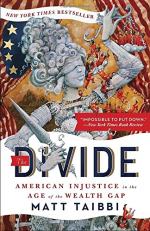|
This section contains 484 words (approx. 2 pages at 400 words per page) |

|
The Divide: American Injustice in the Age of the Wealth Gap Summary & Study Guide Description
The Divide: American Injustice in the Age of the Wealth Gap Summary & Study Guide includes comprehensive information and analysis to help you understand the book. This study guide contains the following sections:
This detailed literature summary also contains Topics for Discussion on The Divide: American Injustice in the Age of the Wealth Gap by Matt Taibbi.
“The Divide – American Justice in the Age of the Wealth Gap” by Matt Taibbi is an examination of the great and ever-expanding divide between the very wealthy and everyone else. The 2008 financial crisis that destabilized the economy of the entire world, Taibbi asserts, was brought about by the lax regulatory overseers including the SEC and the repeal of the Glass-Steagall Act that had been established after the Great Depression. Glass-Steagall basically required banks to stay in the business of keeping money and making small loans, and not get into the investment and insurance markets. Therefore, with its repeal, banks were fundamentally able to do whatever they wanted in order to make a profit.
It has subsequently been demonstrated that many of the activities and transactions that were taking place on Wall Street were corrupt, unscrupulous and criminal. However, not one individual in charge of these banks or hedge funds has been held accountable for their actions. Strangely, the U.S. Justice Department pursued litigation against employees of only one bank – Abacus Federal in Chinatown, New York. This prosecution was intended to be an example to the nation of the government’s pursuit of justice. However, the minor violations that Abacus committed amounted to nothing compared to what had happened on Wall Street. Abacus was just a scapegoat and a cover for the Justice Department’s failure to prosecute the truly egregious crimes committed by larger banks and financial institutions.
The Glass-Steagall Act was repealed during the Clinton Administration and was largely responsible for the economic boom during those years. Taibbi argues that the boom was based on fraudulent deals and exotic home loans that under ordinary circumstances would have never been approved. A harsher, tighter approach to welfare was also established under the Clinton Administration. This led to the bullying and abuse of those applying for government assistance, most of whom were women and minorities. If an individual provided any false information to the government – even the slightest misstatement – the person would lose eligibility for assistance and face both prosecution and prison time.
While Wall Street moneymakers oversaw operations that were corrupt and criminal, and walked away even richer, poor minority women were being sent to jail for providing false information to get $300 a month. While those seeking financial assistance had to be completely honest and forthcoming on the applications, Wall Street executives were known to tell their underlings not to delve too deeply in the qualifications of those seeking loans. One executive told a processor to not even worry if the people were employed.
Throughout “The Divide”, Taibbi continually draws comparisons of the disparities that exist between the very wealthy and everyone else. Those who suffer the most, Taibbi asserts, have the least. Among those who suffer most are African Americans and Hispanic women. The author provides specifics with accounts of actual interviews with many of those described in the book.
Read more from the Study Guide
|
This section contains 484 words (approx. 2 pages at 400 words per page) |

|



